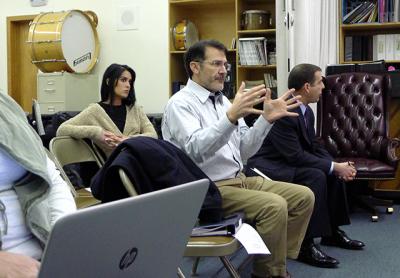Timeline Set for School Expansion

Workers on a $24.7 million expansion of the Bridgehampton School could break ground a year from March, John A. Grillo, the project’s architect, told the school board at a meeting on Tuesday.
Provided all went well, Mr. Grillo said, students would walk into the almost 35,000-square-foot addition on the first day of school in the fall of 2019. The project would more than double the building’s size when completed.
Discussion at Tuesday’s board meeting largely concerned whether the project should be expanded to include an energy-saving geothermal heating and cooling system, money for which was not in the proposal that voters approved on Dec. 13.
Mr. Grillo attended the specially called board meeting to outline what had taken place so far and what the next steps would be. A survey has been completed, and soil tests and utility mapping have also been done. During the Christmas and New Year’s break, members of Mr. Grillo’s team measured the building carefully and began updating their drawings of the existing classrooms and other facilities.
A new gym, locker rooms, fitness center, cafeteria, and science, technology, and music rooms are planned. A portion of the existing gym may be converted into an auditorium, with the balance becoming the new school library. There would be space for two new social studies rooms and a sixth-grade classroom. Planned conversions would create two new English rooms and one for math instruction.
At present, students must cross an outdoor courtyard, skirting a parking lot, to reach aging portable classrooms for music, prekindergarten, science, special education, and home economics.
According to the State Education Department, enrollment from kindergarten through 12th grade was 182 students in the 2015-16 school year. This is up sharply from 138 students in 2012-13. The official figure for the 2016-17 school year is estimated at 211 students.
As the architecture firm moves into the design phase, it would meet with everyone from cafeteria staff to teachers to get ideas about how the additional space should be configured. Conversations might include, for example, whether science room tables should be moveable or fixed. “We get very particular: Should there be places for globe storage?” Mr. Grillo said.
“The fun stuff, the learning environment, doesn’t need to be finalized right now,” he said.
The goal is to send a preliminary design to New York State for Education Department approval by the beginning of June, he said.
The bidding process for selecting a contractor to build the addition would wait until after the state signed off on the structural and mechanical plan. Mr. Grillo estimated that might take about five months from the date that Bridgehampton School completed its required documents. A search for a construction management company could begin after the next school board meeting, which will be Wednesday at 4 p.m.
Bids for the construction itself could be sought by December. Homeowners’ annual school taxes on a property valued at $1 million could rise by as much as $241 once the bond payback period begins.
As the discussion turned to energy use, Mr. Grillo said that he would need to know soon if the board wanted the expansion to meet Leadership in Energy and Environmental Design, or LEED, standards or a geothermal system.
“It is safe to say that the community spoke in asking us to look at LEED and geothermal,” Ron White, the board president said.
Mr. Grillo said that a closed-loop geothermal system would cost between $500,000 and $600,000. State rebates for as much as half the cost could be available, with a 15-year estimated payback on energy savings. Solar photovoltaic panels are planned for above the addition. Mr. Grillo said that they might not be appropriate to place on the existing school building’s 1930s slate roof.
Geothermal cooling would allow central air-conditioning throughout the school, something it does not now have. It would also make summer programs much more comfortable. “This may give you an opportunity to open the building to the community,” Mr. Grillo said.
Seeking LEED certification would add about $100,000 to the nearly $25 million project, he said.
Money for adding a geothermal system could come from the school’s several reserve funds, Robert Hauser, the assistant superintendent for finance and facilities, said. A portion of that would have to be approved by residents, hypothetically in the May budget vote.
“If we say it’s a reduction in fossil fuels, everybody’s hand is going to go up,” Mr. Grillo speculated.
Noah Nadelson of Munistat, the district’s bond advisor, attended Tuesday’s meeting and described how the borrowing to pay for the project would go. He complimented the board on the district’s Aa1 bond rating, which he called “an incredible coup.” There are only two triple-A school districts on Long Island with higher ratings, Great Neck and Southampton. “You can see you are in rarified air there,” he said.
Mr. Nadelson said that he estimated the interest rate on a $24.7 million, 20-year bond offering would come in around 3 percent.
In past bond issues, Bridgehampton National Bank had offered the district what he described as very supportive rates and might be interested in doing so again, he said.
